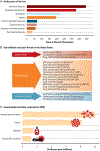Molecular imaging of bacterial infections: Overcoming the barriers to clinical translation
- PMID: 31484790
- PMCID: PMC6743081
- DOI: 10.1126/scitranslmed.aax8251
Molecular imaging of bacterial infections: Overcoming the barriers to clinical translation
Abstract
Clinical diagnostic tools requiring direct sample testing cannot be applied to infections deep within the body, and clinically available imaging tools lack specificity. New approaches are needed for early diagnosis and monitoring of bacterial infections and rapid detection of drug-resistant organisms. Molecular imaging allows for longitudinal, noninvasive assessments and can provide key information about infectious processes deep within the body.
Copyright © 2019 The Authors, some rights reserved; exclusive licensee American Association for the Advancement of Science. No claim to original U.S. Government Works.
Conflict of interest statement
Figures




References
-
- World Health Organization, Global Tuberculosis Report 2018 (World Health Organization, 2018); www.who.int/gho/tb/en/.
-
- Magill SS, Edwards JR, Bamberg W, Beldavs ZG, Dumyati G, Kainer MA, Lynfield R, Maloney M, McAllister-Hollod L, Nadle J, Ray SM, Thompson DL, Wilson LE, Fridkin SK; Emerging Infections Program Healthcare-Associated Infections; Antimicrobial Use Prevalence Survey Team, Multistate point-prevalence survey of health care–associated infections. N. Engl. J. Med 370, 1198–1208 (2014). - PMC - PubMed
-
- Centers for Disease Control and Prevention, The Direct Medical Costs of Healthcare-Associated Infections in U.S. Hospitals and the Benefits of Prevention (Centers for Disease Control and Prevention, 2009); www.cdc.gov/hai/pdfs/hai/scott_costpaper.pdf.
Publication types
MeSH terms
Grants and funding
LinkOut - more resources
Full Text Sources
Other Literature Sources
Medical

